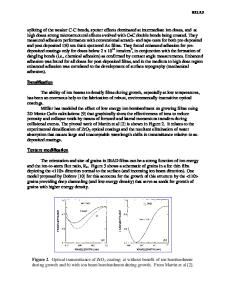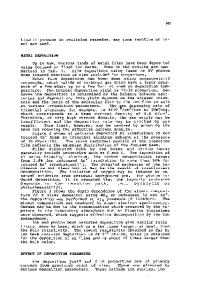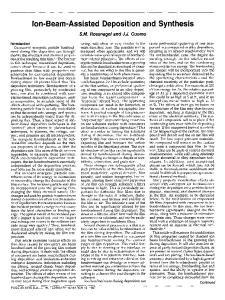MoS 2 deposited by ion beam assisted deposition: 2H or random layer structure?
- PDF / 370,176 Bytes
- 7 Pages / 612 x 792 pts (letter) Page_size
- 84 Downloads / 273 Views
MATERIALS RESEARCH
Welcome
Comments
Help
MoS2 deposited by ion beam assisted deposition: 2H or random layer structure? D. N. Dunn, L. E. Seitzman, and I. L. Singer Naval Research Laboratory, Code 6176, Washington, DC 20375 (Received 11 August 1997; accepted 27 March 1998)
The structure of MoS2 films grown by ion beam assisted deposition is investigated using transmission electron microscopy. Films consist of stacks of S–Mo–S planes with a [001] texture; however, three-dimensional crystal symmetry is disrupted by a high density of planar defects. Selected area electron diffraction patterns show (hk0) and (00l) reflections, features similar to a random layer structure, as well as diffuse (103) reflections. It is suggested that these films do not have a true random layer structure, but rather a two-dimensional structure formed by nonrandom in-plane translations. I. INTRODUCTION
II. EXPERIMENTAL
The microstructure of MoS2 films grown by ion beam assisted deposition (IBAD) was recently shown to consist of basally oriented S–Mo–S planes with a high density of planar defects.1 The defects were designated F- and T -type defects; F indicates that a single plane forks into two planes, and T that a single plane terminates between two planes. Similar defects can be found in MoS2 films grown by other methods, such as sputtering.2,3 In most instances, the crystallographic structure of these films has been interpreted in terms of the 2H polytype usually associated with natural molybdenite. However, a few authors4–6 have suggested that these films have a random layer structure (RLS), sometimes called “turbostratic,” first associated with carbon black.7,8 Moser and Levy have demonstrated that sputter deposited MoS2 films, grown under certain conditions, can produce x-ray and selected area electron diffraction features consistent with RLS.9 The distinction between these two structures is significant, because the 2H structure has three-dimensional symmetry, whereas the RLS has only two-dimensional symmetry. In RLS, atoms within S–Mo–S planes occupy the same lattice sites as in the 2H polytype, but adjacent planes are randomly translated. Because this breaking of symmetry between adjacent basal planes should have a significant influence on the friction and wear behavior of MoS2 films, it is important to identify the structure of these films. The purpose of this paper is to determine the crystal structure of an IBAD MoS2 film containing F- and T -type defects. Transmission electron microscopy images and diffraction patterns of cross-sectioned MoS2 films are presented. Defects are identified and diffraction and image data are interpreted in terms of several twodimensional and three-dimensional structures. We argue that a two-dimensional structure can account for the images and the diffraction patterns.
IBAD MoS2 films were deposited over a TiN interlayer on Si(100) using conditions known to produce basally oriented films (substrate temperature of 473 K and an ion-to-atom ratio of 0.046).5,10 The TiN interlayer prevents diffusion
Data Loading...










